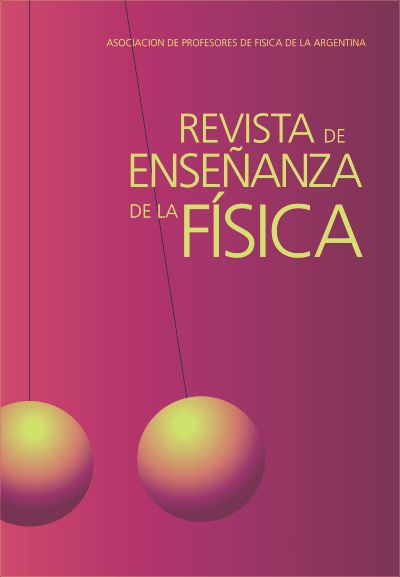Solving transcendental equations of physics with Chebyshev's method
DOI:
https://doi.org/10.55767/2451.6007.v34.n2.39487Keywords:
Transcendental equations, Chebyshev, Mathematics, Physics, Root-finderAbstract
In this work, physics teachers are provided with an optimized method to solve transcendental equations that cannot be solved algebraically and appear very often in higher education physics and engineering courses. The method is based on an interpolation with Chebyshev’s polynomials, and it is optimized for computational time, manageability, and accuracy. The method has been applied in specific problems of physics where transcendental equations appear, such as the compression of a real spring; the equation of a diode; the solution of the Schrödinger equation in a potential well; and the computing of cutoff wave numbers of a coaxial wire. The method is compared with others of the literature to check its correct behavior and the improvements that it presents. MATLAB source codes to implement the method and particular examples are also provided.
References
Aranzabal Olea, A. (2001). Modos de resolución de circuitos con diodos. Recuperado el 10 de agosto de 2022, de http://www.sc.ehu.es/sbweb/electronica/elec_basica/tema3/Paginas/Pagina6.htm
Austin, A., Kravanja, P. & Lloyd N., T. (2014). Numerical algorithms based on analytic function values at roots of unity. SIAM Journal on Numerical Analysis, 52(4), 1795-1821.
Bohm, D. (1989). Quantum Theory. New York: Dover.
Boyd, J. (2002). Computing zeros on a real interval through Chebyshev expansion and polynomial rootfinding. SIAM Journal on Numerical Analysis, 40(5), 1666-1682.
Boyd, J. (2014a). Finding the zeros of a univariative equation: Proxy rootfinders, Chebyshev interpolation and the com-panion matrix. Philadelphia, United States: Society for Industrial and Applied Mathematics.
Boyd, J. (2014b). Solving Transcendental Equations: The Chebyshev Polynomial Proxy and Other Numerical rootfinders, Perturbation Series, and Oracles. Philadelphia, PA, USA: Society for Industrial and Applied Mathematics (SIAM).
FCenRed. (2014, octubre 14). El pozo cuadrado finito. Física cuántica en la red. http://www.fisicacuantica.es/pozo-cuadrado-finito/
Galindo, A. y Pascual, P. (1989). Mecánica Cuántica. Madrid: Eudema.
Ma, D. (26 de Marzo de 2010). General Mathieu functions with arbitrary parameters V1.0. Recuperado el 2 de agosto de 2022, de: https://www.mathworks.com/matlabcentral/fileexchange/27101-general-mathieu-functions-with-arbitrary-parameters-v1-0
Morris, S. (29 de mayo de 2007). Real roots on interval. Recuperado el 2 de agosto de 2022, de https://www.mathworks.com/matlabcentral/fileexchange/15122- real-roots-on-interval
Peñaranda Foix, F. L. (2010). Números de onda de corte de los modos superiores TE y TM de un coaxial. https://riunet.upv.es/handle/10251/8070
Pozar, D. (1998). Microwave Engineering. New York: Wiley & Sons, Inc.
Quinga, S. (2021). Ecuaciones no lineales en física y su resolución mediante el uso de métodos iterativos multipaso de orden alto. Revista Enseñanza de la Física, 33(3), 145-165.
Sze, S. & Kwok, K. (2007). Physics of semiconductors devices. Taiwan: John Wiley & Sons, Inc.
Published
How to Cite
Issue
Section
License

This work is licensed under a Creative Commons Attribution-NonCommercial-NoDerivatives 4.0 International License.
Aquellos autores/as que tengan publicaciones con esta revista, aceptan los términos siguientes:Los autores/as conservarán sus derechos de copiar y redistribuir el material, bajo los términos estipulados en la Licencia de reconocimiento, no comercial, sin obras derivadas de Creative Commons que permite a terceros compartir la obra bajo las siguientes condiciones:
- Reconocimiento — Debe reconocer adecuadamente la autoría, proporcionar un enlace a la licencia e indicar si se han realizado cambios. Puede hacerlo de cualquier manera razonable, pero no de una manera que sugiera que tiene el apoyo del licenciador o lo recibe por el uso que hace.
- NoComercial — No puede utilizar el material para una finalidad comercial.
- SinObraDerivada — Si remezcla, transforma o crea a partir del material, no puede difundir el material modificado.
- Los autores/as podrán adoptar otros acuerdos de licencia no exclusiva de distribución de la versión de la obra publicada (p. ej.: depositarla en un archivo telemático institucional o publicarla en un volumen monográfico) siempre que se indique la publicación inicial en esta revista.
- Se permite y recomienda a los autores/as difundir su obra a través de Internet (p. ej.: en archivos telemáticos institucionales o en su página web) antes y durante el proceso de envío, lo cual puede producir intercambios interesantes y aumentar las citas de la obra publicada. (Véase El efecto del acceso abierto).














